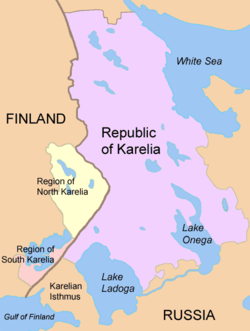Republic of Karelia
|
|
- For other uses of Karelia, see Karelia (disambiguation).
The Republic of Karelia (Russian: Респу́блика Каре́лия; Karelian: Karjalan Tazavalla) is a federal subject of the Russian Federation (a republic). The direct transliteration of the republic's name is Respublika Kareliya. Karelia is called Karjala in Finnish. Template:Federal subject of Russia
| Contents |
Geography
The Republic is located in the north-western part of the Russian Federation, taking intervening position between the basins of White and Baltic seas. The White Sea shore line is 630 km.
The most part of the republic's territory (148,000 km², or 85%) is comprised of state forest stock. The total growing stock of timber resources in the forests of all categories and ages is 807 million m³. The mature and overmature tree stock amounts to 411.8 million m³, of which 375.2 million m³ is coniferous.
- Area: 172,400 km².
- Borders:
- internal: Murmansk Oblast (N), Arkhangelsk Oblast (E/SE), Vologda Oblast (SE/S), Leningrad Oblast (S/SW)
- international: Finland (SW/W/NW) (border line length: 723 km)
- water: White Sea (an inlet of the Barents Sea) (N/NE/E), Onego Lake (SE), Lake Ladoga (SW)
- Highest point: no data.
Time zone
The Republic of Karelia is located in the Moscow Time Zone (MSK/MSD). UTC offset is +0300 (MSK)/+0400 (MSD).
Rivers
There are 27,000 rivers in Karelia. Major rivers include:
Lakes
There are 60,000 lakes in Karelia. Republic's lakes and swamps contain about 2,000 km³ of high-quality fresh water. Lake Ladoga and Lake Onego are the largest lakes in Europe. Other lakes include:
Natural Resources
50 useful minerals are found in Karelia, located in more than 400 deposits and orebearing layers. Natural resources of the republic include iron ore, diamonds, vanadium, molybdenum, and others.
Administrative division
- Main article: Administrative division of the Republic of Karelia
Demographics
Karelia is populated chiefly by Russians (73.6% of the population) and (ethnically Finnic) Karelians (10.0%). Other ethnic groups include Belarusians (7.0%), Ukrainians (3.6%), and Finns (2.3%).
- Population: 716,281 (2002)
- Urban: 537.395 (75.0%)
- Rural: 178,886 (25.0%)
- Male: 331,505 (46.3%)
- Female: 384,776 (53.7%)
- Females per 1000 males: 1,161
- Average age: 37.1 years
- Urban: 35.9 years
- Rural: 40.6 years
- Male: 33.9 years
- Female: 39.9 years
- Number of households: 279,915 (with 701,314 people)
- Urban: 208,041 (with 525,964 people)
- Rural: 71,874 (with 175,350 people)
History
Historically Karelia was a region to the northwest of Russia, east of present-day Finland. From the 13th century and onwards various parts were conquered by Sweden, and incorporated into Swedish Karelia until they were lost to Russia by the Treaty of Åbo in the middle of the 18th century.
In 1923 the province became the Karelian ASSR (Karelian Autonomous Soviet Socialist Republic). From 1940 it was made into the Karelo-Finnish SSR, incorporating the Finnish Democratic Republic created during the Winter War. Occupied territories incorporated into Karelo-Finnish SSR after Winter War but not after Continuation War. Name was changed back to a ASSR in 1956. During the Continuation War in 1941 Finland occupied parts of the area but was forced to withdraw in 1944.
The autonomous Republic of Karelia in its present form was formed on November 13, 1991.
Politics
The head of government in the Republic of Karelia is the President. As of 2004, the president is Sergey Leonidovich Katanandov, who was elected in May of 2002.
Culture
The Karelian language is close to Finnish, and in recent years, it has been considered a dialect of Finnish. Nevertheless, far Eastern Karelian might not be completely mutually intelligible with Finnish and could be considered a proper language. Finnish and Russian are the official languages of the republic.
Karelia is sometimes called "the songlands" in the Finnish culture, as Karelian poems constitute most of the Finnish national epic Kalevala.
Religion
The Karelians have been traditionally Russian Orthodox, known in Finland for their small chapels called tsasouna. However, Lutheranism was brought to the area by the Finnish immigrants during Sweden's conquest of Karelia.
Related articles
External links
- Official website of the Republic of Karelia (http://gov.karelia.ru/gov/index1.html) (in English, Russian, and Finnish)
- Karelia.ru web server (http://www.karelia.ru) (in English, Russian, and Finnish)
- Window to Karelia server (http://www.onego.ru/english.html) (in English, Russian, Karelian, and Finnish)
- Heninen.net (http://heninen.net/list.cgi?L=0) - various information about Karelia (in English, Russian, and Finnish)
- Information about Karelians (http://www.eki.ee/books/redbook/karelians.shtml) (in English)
- Virtual Finland (http://virtual.finland.fi/finfo/english/karjala.html) - "The Many Karelias" article (in English)
- Russian Business Site (http://www.russianbusinesssite.com/maps/karelia.html) - Map of the Republic of Karelia (in Russian)
Template:Russian federal subjectscs:Republika Karélie de:Republik Karelien et:Karjala Vabariik fi:Karjalan tasavalta ja:カレリア共和国 ko:카르얄라 공화국 nl:Karelië ru:Карелия tt:Kareliä uk:Республіка Карелія zh:卡累利阿共和国


